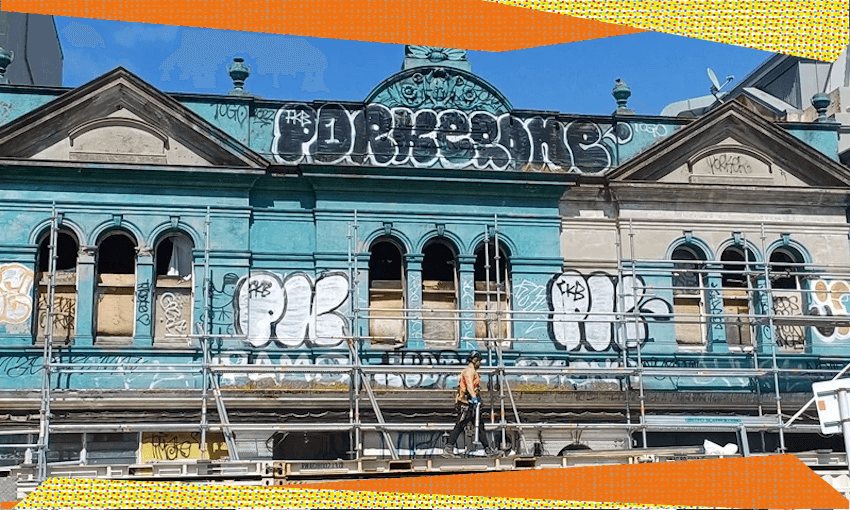A suspected arson attack has seen a heritage-listed building demolished. Joel MacManus argues why that’s good for Wellington.
Police are still looking for four young people who were seen at the site of Wellington’s Toomath’s building before it burned down last week. Perhaps the people of Wellington should also be looking for them, to say thank you and give them some kind of reward.
The heritage-listed Toomath’s building on Ghuznee St was red-stickered in 2013 after missing an earthquake strengthening deadline. It was cordoned off since 2019. After years of inaction from the building’s owner Dayal Govan, Wellington city council won a landmark court case that allowed it to take control of the building, strengthen it, and charge the costs back to the owner. The council dropped its bid earlier this year after Govan promised to begin repairs, months before the building burned down.
The Toomath’s building is not individually listed by Heritage New Zealand, but was protected by the council as part of the broader Cuba Street Heritage Area. It was built in 1900 using money from the estate of William Toomath, a prominent early settler.
Heritage protections doomed the Toomath’s building to squalor and this fire is a chance to tear it down and build something new. It’s a win/win for everyone involved. Firstly and most importantly: it’s a win for human life. No one died and no one was hurt.
It’s a win for the owner of the building, who now won’t have to go through with eye-wateringly expensive earthquake-strengthening repairs.
It’s a win for pedestrians, who will no longer have to walk along the footpath through a hideous tunnel of shipping containers out of fear chunks of masonry will fall on them.
It’s a win for the wider Ghuznee St precinct, which will have a more pleasant streetscape now that the footpaths aren’t taken up by a hideous tunnel of shipping containers.
It’s a win for Wellington businesses and residents, who will benefit from whatever new building is erected in its place, which is likely to have better retail spaces, offices or apartments.
It’s a win for the council too; a new building will almost certainly have a higher property value and generate more rates. It could have flow-on effects that improve the value of the buildings around it.
When a normal building is damaged by an earthquake, the owner can run the numbers and make a clear choice based on construction costs: is it better to repair it, or knock it down and build something new?
Owners of heritage-listed buildings, however, usually don’t have the option of demolition (at least not without a difficult and costly court case), and repairs are more expensive due to outdated materials and strict design requirements. For the owner of the Toomath’s building, there was apparently no plausible option to strengthen and it became easier to just pay the annual rates while the building sat empty, collapsing from the inside and sucking the life out of the city around it.
Wellington city council recognises heritage protections on 586 buildings, while Heritage New Zealand lists 612 buildings in the wider region. The capital has a large and influential community of heritage advocates who are passionate about older buildings and want to see them protected, but excessive protection comes at the cost of growth. Many of the same (mostly older, wealthy) residents fought for character protections on old villas in the inner suburbs, which prevented new homes from being built and exacerbated the housing crisis.
Wellington is an earthquake-prone city. City leaders talk a big game about being resilient and sustainable, but to be truly resilient, Wellington needs to be dynamic. We need to build things that can withstand shaking, and be willing to tear things down and move on when they no longer work. Successful cities are not stuck in time, they are constantly evolving.
Mt Cook’s Adelaide Hotel should be a high-density apartment building on a key transit route but because of a heritage listing it sits empty. The Band Rotunda in Oriental Bay should be a brand new restaurant and bar, but instead, beachgoers sunbathe next to a faded ruin. The Gordon Wilson Flats should be demolished so new housing and business development can be built in their place, but the Environment Court won’t allow it. There are at least 37 heritage-listed buildings that will hit their earthquake-strengthening deadlines this decade and could become Wellington’s next abandoned eyesore.
If the owners of heritage buildings aren’t able to fix them and aren’t allowed to tear them down, maybe they should just start leaving their doors open at night and hoping the Toomath teens stop by.



